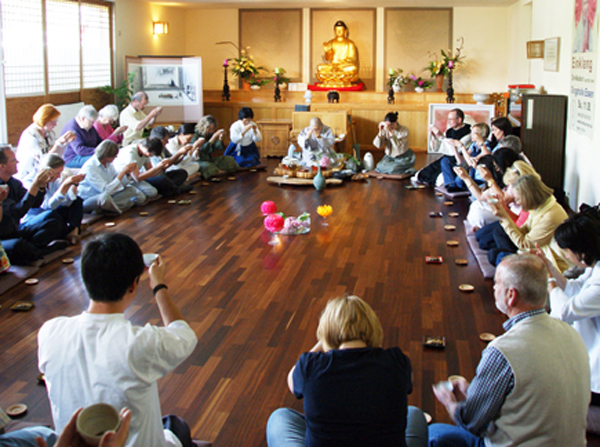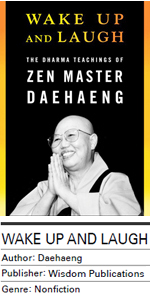Laughter is key to life, says Zen master

Devout followers of the Zen master Daehaeng practice Zen Buddhism every week during the Dharma talks at the Hanmaum International Zen Center in Anyang, Gyeonggi. Provided by the Hanmaum International Cultural Institute
On diverse questions from her devout followers - ranging from mundane ones such as “How can my fiance and I get along better and become one?” to spiritual ones like “What will happen to us if we can’t cross the river after we die?” and scientific ones “How does Buddhism explain the beginning of the world?” - the Zen master answers them all - sometimes straightforwardly and sometimes allusively - in her famous Dharma talks at the Hanmaum International Zen Center in Anyang, Gyeonggi.
As the title of her earlier book succinctly suggests, this text is based on her unflinching faith in the mantra that enlightenment is already here, if you know what you are looking for, as every single moment in your daily life is the path to the truth. The first step, of course, is to let go of every attachment and entrust it to your true, or Buddhist, nature, or “the foundation,” which is inherently complete within us. That thought is the shortcut to breaking out of ignorance and a bridge leading to the ultimate awakening.

Master Daehaeng’s Dharma talks also provide some food for thought with regard to the Sewol ferry tragedy, which killed hundreds of students.
“Bodhisattvas don’t even cling to life or death, so how could they be caught by anything else?” she asks.
Yet unenlightened beings are so attached to life and death because they view living and dying through the lens of desire and aversion. So Daehaeng preaches to let go of both the thoughts of “I am going to die” and “I don’t want to die.”
“Even if you are on the verge of dying right now, it’s not a big deal. You can’t die twice,” she said.
At the same time, the master emphatically urges people to see the pain of others as theirs and see them as their own children, parents and siblings, along with a karmic exhortation profoundly rooted in samsara, the endless cycle of birth, death and rebirth. “Do not see even a plant as something separate from yourself as all living things around you are interconnected to one another in an overarching karmic dimension. When we build such a way of thinking and practicing, we can finally attain an insight to the universe far beyond the confinement of the present,” she said.
Born in 1927 to an aristocratic family in Seoul, she was ordained as a Samini - the first level of ordination for a female monk - in the spring of 1950 and set up the international Zen center to teach her faith to foreigners, too.
For many who are still struggling with the tragedy at sea, this book offers a profound guiding light and practical solutions to a myriad of intriguing questions.
BY KANG TAE-UK [tkang@joongang.co.kr]










with the Korea JoongAng Daily
To write comments, please log in to one of the accounts.
Standards Board Policy (0/250자)